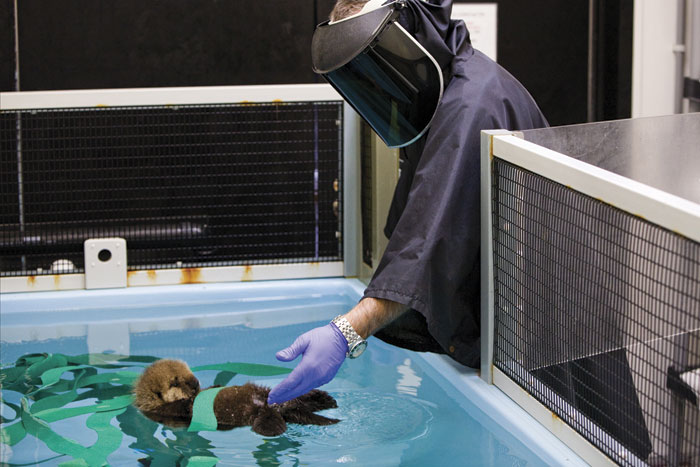It’s low tide at Moss Landing and the mudflats add a sulfur scent to the salty air. Cormorants, gulls, pelicans, and a smattering of shorebirds ignore our small motorboat puttering through the calm waters of Elkhorn Slough, an estuary that winds east through farm fields. To my left, a sea otter rolls onto his back, slurping the length of a red, fat innkeeper worm like a strand of spaghetti. Ahead, a dozen more otters float on their backs, wrapped in ribbons of eelgrass to tether themselves against the tide.
The slough, roughly halfway between Santa Cruz and Monterey, is a sea otter boomtown. More than a hundred of these small marine mammals (somewhat bigger relatives of river otters) make their home in the seven-mile stretch of salt marshes and shallow waters. Compared to the nearshore Pacific waters where most southern sea otters live, this estuarine environment gives both citizen and academic scientists a chance to observe them closely.
A couple of decades ago, less than two dozen male otters used the slough, notes Ron Eby, my boat pilot. A retired naval officer, Eby watches otters here and collects data for scientists as a volunteer. Those males had come up the coast from Big Sur, he explains, descendants from a colony that survived after hunters had killed off most southern sea otters by the early 1900s.

In their heyday, more than 16,000 southern sea otters ranged from southeastern Alaska to Baja, California. An international fur seal treaty in 1911, along with federal laws and the Marine Mammal Protection Act put in place in the 1970s, was meant to help those populations rebound from the fur trade. Only recently have they started to succeed. U.S. Geological Survey (USGS) scientists count otters annually and use a three-year running average as the official measure of their abundance. The three-year average in 2016 was 3,272, a number that topped the delisting threshold of 3,090 for the first time. Before qualifying for delisting, however, the otter population must exceed that threshold for three consecutive years.
“The news is both good and bad,” says Tim Tinker, a USGS biologist who leads the annual otter census. “The overall numbers are up, but their range isn’t increasing. The edges of the range, between Davenport and Half Moon Bay in the north and from Pismo Beach to Point Conception in the south, are the engines of expansion. Those engines are stalling, so there is reason for concern.”
Fifteen years ago the otter population in the slough faced its own expansion problem. Without females, there wasn’t much hope of increasing the population. Around that time, the Monterey Bay Aquarium’s Sea Otter Research and Conservation program took in a pregnant young female, suffering from seizures, that had been stranded along Monterey’s coast. Although Toola’s seizures, caused by a parasite, were successfully managed with daily medications, her pup was stillborn and she couldn’t go back to the wild with a neurologic disease. Primed for motherhood, Toola willingly adopted a 2-week-old orphaned pup known as #217 after they spent time together in a private pool. The pup thrived, and after it was released into Elkhorn Slough, survived for more than a decade.
At the same time Toola’s surrogacy began, another of the aquarium’s resident female otters, Joy, also adopted a pup (#209), even though she hadn’t been pregnant and wasn’t lactating. Those first successful adoptions laid the groundwork for a new way of rearing orphaned pups with surrogate sea otter “moms” instead of relying solely on human caregivers, says Karl Mayer, the animal care coordinator for the aquarium’s sea otter program.
Even with surrogates, raising an otter pup is hard work. In the wild, female otters tend their pups for at least six months, rarely letting their offspring out of sight. At the aquarium, a team of people care for the baby otters almost around the clock until the pups are eating solid food. The caretakers wear dark cloaks and face shields so the young otters never get used to seeing people. By eight weeks of age the pups have shed their natal coats—a pelage so buoyant the pups float like corks, says Mayer—and are ready to meet their otter “mom.” Then the surrogate takes over, teaching the otter pup how to find food, groom, and other staples of otter upkeep, until the pup is ready to be released into the slough at around seven months of age.
Since Toola’s first pup, in 2001, there have been 40 successful releases. The survival and reproductive rates of surrogate-reared pups mirror those of wild-raised sea otters in Central California, as well as of the Elkhorn Slough population. At least eight females have survived and reproduced, Mayer notes. But the biggest finding was that the surrogate-reared otters and their descendants account for over half the current population in the slough.
That growth in the slough might have happened without the surrogate program, given that female otters already lived in coastal areas to the north and south and could have eventually found their way to the estuary. But it’s unclear how long that might have taken, says Tinker, who generated a model to sort out the aquarium program’s contributions. “What is clear is that this growth was greatly accelerated by the surrogacy program,” he says.
More important, according to Mayer: “Now we have the means to reliably rear orphan pups and release them back into the wild. If these methods are repeatable in other areas, this could wind up being a very valuable tool for conservation.”

As the otter population grew in Elkhorn Slough, scientists discovered more about them, thanks in part to volunteer teams led by Eby and his otter-spotting partner, retired law enforcement officer Robert Scoles. Those citizen scientist observations really help, notes Kerstin Wasson, the research coordinator at Elkhorn Slough Reserve. “People who spend hours outside, getting to know a place and its patterns, can really change how we see the habitats surrounding us,” she says.
In one study, preliminary results show the slough is truly home for about 140 otters, a finding at odds with the prevailing idea that otters were nearshore coastal residents that just visited the estuary. Then again, why would they leave? Without blubber to insulate them from the cold water, to stay warm the otters rely on their dense coat and a daily caloric intake equal to at least 25 percent of their body weight. In the slough, food is abundant and easy to find. With easier foraging, the otters maintain better body condition, with less effort, than their nearshore kin.
It turns out that sea otters are also good for the slough. Flanked by agricultural fields, the water runoff is rich with fertilizers, making the estuary prone to algal blooms that can create a deadly shade for seagrass. The otters set off a cascade of effects that lead to a healthier ecosystem, according to a study led by UC Santa Cruz researcher Brent Hughes. In this multilevel “trophic cascade,” more otters eating more crabs, enables more algae-eaters to survive and keep the eelgrass beds clean, which allows them to flourish.
Even this watery Garden of Eden has limits, though. The otters are nearing the carrying capacity of the slough, so the population needs to grow somewhere else. Males usually colonize a new habitat first and are eventually followed by females, but the process can be slow.
What’s been stopping them? White sharks, biologist Tim Tinker says.
Sharks aren’t the only mortal problem sea otters face; they also die from infectious diseases, parasites, and seafood toxins. However, especially at the southern end of their range, from Estero Bay (north of Morro Bay) to Point Conception, more than 50 percent of stranded otters show lethal white shark bites, according to a study Tinker has led. In areas with an eightfold increase in shark bites the otters’ death rates exceed birthrates, so their local populations are declining and range expansion has stalled.
The success story in the slough has people wondering what southern sea otters could do for other estuaries: perhaps help restore the salt marshes of San Francisco Bay, where the animals once lived in large numbers. The thought lights up Eby’s face. “Wouldn’t that be incredible to have sea otters back in the Bay?” he says.





